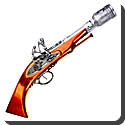 Blunderbuss probably derives its name from the German donder buchse, ‘thunder gun’. The gun was built with a bell-shaped barrel – wider at the muzzle than the breech. This amplified the noise of the explosion. The weapon was loaded with a number of small balls and it was thought that the bell-mouth would cause the shot to spread. But it was later discovered that this did not in fact increase the spread of the pellets on leaving the barrel. There is mention of the weapon in England as early as the seventeenth century. In 1654 ‘a hundred brass blunder bushes’ were ordered as equipment for the Hispaniola expedition. It would seem that the period of the blunderbuss’s greatest popularity was the last quarter of the eighteenth century. Blunderbusses were in demand as personal protection weapons, and were carried by the guards on Royal Mail coaches and on the old stage coaches in the United States, before the day of the double-barreled shot gun. The big gapping muzzle no double was reckoned to have a frightening effect on robbers. It was a sea-going weapon, too, being used to repel boarders – or to shatter a ship’s rigging. Some types of blunderbuss were fitted with a bayonet.
Blunderbuss probably derives its name from the German donder buchse, ‘thunder gun’. The gun was built with a bell-shaped barrel – wider at the muzzle than the breech. This amplified the noise of the explosion. The weapon was loaded with a number of small balls and it was thought that the bell-mouth would cause the shot to spread. But it was later discovered that this did not in fact increase the spread of the pellets on leaving the barrel. There is mention of the weapon in England as early as the seventeenth century. In 1654 ‘a hundred brass blunder bushes’ were ordered as equipment for the Hispaniola expedition. It would seem that the period of the blunderbuss’s greatest popularity was the last quarter of the eighteenth century. Blunderbusses were in demand as personal protection weapons, and were carried by the guards on Royal Mail coaches and on the old stage coaches in the United States, before the day of the double-barreled shot gun. The big gapping muzzle no double was reckoned to have a frightening effect on robbers. It was a sea-going weapon, too, being used to repel boarders – or to shatter a ship’s rigging. Some types of blunderbuss were fitted with a bayonet.
Check Also
मातृभूमि: सोहनलाल द्विवेदी – भारत के प्राकृतिक सौंदर्य और समृद्धि पर हिंदी कविता
मातृभूमि कविता में कवि सोहनलाल द्विवेदी जी ने भारत के प्राकृतिक सौंदर्य और समृद्धि का …
 Kids Portal For Parents India Kids Network
Kids Portal For Parents India Kids Network






